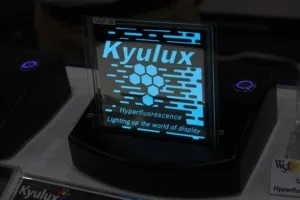TADF (thermally activated delayed fluorescence) is a clever quantum-mechanical trick that permits us to make use of the the three quarters of quantum states in fluorescent OLED emitters that are usually unavailable, thus increasing the internal quantum efficiency from 25% to 100%. Universal Display Corporation (UDC) already does this with red and green phosphorescent OLED emitters, which appear in commercial OLED displays ranging from the smart-phone displays made by Samsung Display to the TV displays made by LG Display.
If you are hopelessly cynical, you might say that the main reason to pursue TADF is to find a way around UDC’s impressive patent portfolio. If you have a more benevolent nature, you might observe that, although UDC has very nice red, green and yellow phopshorescent materials, they have not yet been able to develop a long-lived deep blue that would make an all-phosphorescent OLED display possible. Current displays use UDC’s phosphorescent red and green (or, in LG Display’s case, yellow) and then fill out the spectrum with a fluorescent blue.
There may be uses for TADF greens, reds, and yellows, but once you have appreciated the creative synthetic chemistry and quantum physics involved, these materials are are not going to change the OLED display game in any fundamental way. What the industry wants is a “deep blue,” as opposed to a “sky blue,” which may have applications in lighting but not in displays, at least not in any straightforward way. (UDC has demonstrated a four-subpixel configuration that use both sky blue and deep blue to reduce the ageing of the short-lived deep blue emitter, but this has not appeared in any commercial display as far as I know.) (I believe LG does use two different blues, but don’t know the source – BR)
Fig. 1: Kyulux’s sky blue TADF OLED emitter in the company’s SID booth. (Photo: Ken Werner)
Moving to Gen 3.5
In the last few years the general attitude toward TADFs has evolved from skeptical curiosity to hopeful respect. In his Sunday seminar “OLEDs: Recent Progress and Applications, Jian Li of Arizonal State University said “I used to be a doubter.” Although he no longer doubts, Li said “[It is] difficult to push TADF design forward.” However, people are developing new device architectures in their search for “a new route to harvest triplets.”
If OLED Generation 1 is fluorescence, Gen 2 is phosphoresence, and Gen 3 is TADF, then a more recent approach, TADF-assisted Fluorescence (TAF), could be considered Gen 3.5. The advantage of TAF, said Li, is that it that it expands the molecular design possibilities beyond TADF, thus increasing the likelihood of being able to synthisize molecules with the desired color coordinates (such as “deep blue”), lifetime, and efficiency.
TADF On the Floor
On the show floor, the range of TADF developers ran from C to K; that is, from Cynora to Kyulux. Kyulux, the Japanese company founded in 2015 on the basis of technology licensed from Kyushu University, showed green, yellow, and sky blue TADF OLED emitters. Daniel Tsang told Display Monitor that the green and yellow are in customer development, while the sky blue is still in development in-house (Fig. 1). A deep blue is possible he said, but lifetime still needs improvement. I could find no Kyulux paper in the technical program.
In Technical Paper 13-4, Thomas Baumann and Matthias Budzinsky of the German company Cynora said that one problem with deep blue emitters is that they have too broad an emission spectrum, but that by using molecular design principles, Cynora increased the percentage of narrow emitters from about 15% to nearly nearly 50% over the first three quarters of 2017. The team’s most recent results “of 14% EQE [external quantum efficiency] at a CIEy coordinate of 0.15 [deep blue] with a lifetime LT97 [lifetime measured to 97% of initial luminance] at 700 cd/m² of ~10 hours show that blue TADF emitters are not far from mass production specifications.” The specifications for volume production “are typically considered to be around 0.15 CIEy, 15% EQE and >100h LT97 at 700 nits. We therefore expect that our blue TADF emitters can be found in first products by 2019 after all the necessary processing tests will have been done in 2018.
In the company’s booth, Cynora CEO Gildas Sorin gave Display Monitor more recent results for TADF blue: 20% – 26% EQE and LT97 (700 cd/m²) of 20 hours. Early last year tthat lifetime was only one minute, Sorin said. This compares to an EQE for fluorescent blue OLEDs of 7% and an LT97 of 150 hours.
This allows Cynora to focus on lifetime exclusively, Sorin said, a much easier task than having to work on color coordinates, efficiency, and lifetime all at once, which is the challenge facing Cynora’s competitors, said Sorin. However, Sorin was more conservative than his technical colleagues in predicting commercial introduction. He hopes to achieve their lifetime goal in the middle of 2019, with commercialization at the end of 2020. — Ken Werner

